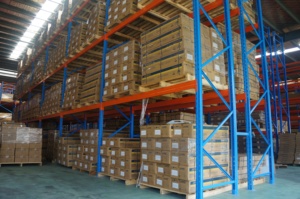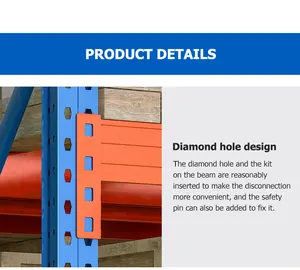
All categories
Featured selections
Trade Assurance
Buyer Central
Help Center
Get the app
Become a supplier

(642 products available)








































When searching for warehouse racking systems, buyers often prioritize the type of rack because it directly affects inventory management. Double deep selective rack is one of the most effective and widely adopted structures.
This type increases selectivity for pallet storage, ensuring the warehouse can store different products while enhancing easy accessibility. Below are some of the most commonly used double-deep-selective racks.
These are assembly units that hold pallets in two consecutive depths, exposing only one side for forklift retrieval. Warehouse pallet racks are beneficial in large open warehouse spaces with long inventory turnover. These spaces can afford deep storage.
As the name implies, double-sided double-deep racks provide two sides of storage, each accommodating pallets in two depths. These systems support pallets to be drawn from either side. Selling double-sided racking is great for large warehouses with significant bulk storage needs, as they offer inventory easy access on both sides.
This type of racking system features mobile or moving shelves/units that can be shifted and locked electronically, manually, or mechanically. This feature enables rods to be closely spaced when not in use and to space them apart when space for a certain rod is needed. This system saves up space and increases the quantity of items that can be stored in a warehouse. It is suitable for warehouses that have varying inventory needs.
This type features an offshoot arm on one or both sides of the racking system. This design is suitable for long and awkwardly shaped products. Those products can be plumbing supplies, lumber, or steel. Adjustable cantilever racks provide easy access through the selective racking structure.
These systems offer loading and unloading through one or both sides using a lift truck or a vehicle. This feature facilitates mass storage based on last-in-first-out or first-in-first-out. It does that while utilizing fewer aisles. These systems suit warehouses dealing in large quantities of products with similar turnover rates.
Many warehouse managers often consider the durability and strength of Warehouse shelving. These two factors are usually influenced by the materials used to design the selective racks.
Steel
Steel is used to make double deep selective racks due to its tensile strength and rigidity. HR steel also bonds very well with paint and coatings, increasing its resistance to corrosion and chemicals.
I-beam, C-channels, and square tubes are some of the common structural profiles used to make double-deep-selective racks. They provide load-carrying capabilities and stiffen the construction.
Galvanized or powder-coated steel finishes provide additional rust and corrosion protection. Therefore, they protect the racks from either chemical spills or moisture exposure within the working environment or outdoors.
Cold-formed steel
Cold-formed steel is used to make lighter double-deep racks. These racks provide high-quality cohesive sections that efficiently utilize energy. It is also resistant to corrosion.
It is used to manufacture components, like cross braces and perforated upright frames, which offer flexibility as well as a lightweight structure that can support moderate loads. These sections are designed to achieve maximum strength with minimum use of material.
Design for double-deep selective racks
The design of double-deep selective racks depends on their operational objectives and what type of product they will store. Steel utilized to make the racks can be shaped into various designs with upright-post sections that support multiple horizontal beams at different heights.
Cross-bracing is then added to increase stability. This is especially needed in high-load or seismic zone conditions. Beam-load height adjustments are essential features incorporated into double deep selective racks.
These features allow flexibility as well as future expansion capabilities. Choosing the right level of adjustable beams enables the user to vary storage heights and accommodate products of various sizes.
Double deep-selective racks are popular among warehouse managers because of their proven storage efficacy. These racks provide the means to store large amounts of similar products while enhancing easy access.
Bulk commodity storage
Double deep-selective racks are ideal for warehouses storing single-product lines in large quantities, like beverages, groceries, and industrial supplies. Such products are stored in two pallets deep per bay, maximizing vertical space and reducing aisle widths.
Accessing one pallet per bay is made easier by forklifts, further improving efficiency. It is for this reason that these racks are suitable for high-volume storage requirements.
Inventory management in distribution centers
Distribution centers usually apply selective racks to facilitate inventory turnover and provide easy access to various products. Selective pallet racks allow products to be easily retrieved for order fulfillment.
This is, of course, when the said products are stored in ascending order of accessibility. This practice exemplifies how DCs handle massive quantities of incoming and outgoing shipments while managing diverse inventories.
Automotive and aerospace parts storage
Auto and aerospace industries usually deal with large inventory levels of detailed equipment and components. Most of these parts are usually either small-sized or difficult to physically handle.
Double-deep selective racks provide an efficient means of storing these parts and making them more easily accessible during maintenance and production. Their unique structure allows easy identification and retrieval of specific items from a vast inventory.
Retail warehouse consolidation
Retail businesses that operate large warehouses normally find huge palletized merchandise storage in Warehouse racks for sale, especially in massive bulk and varied product categories.
Double deep-selective racks strike a balance between access and storage density. They allow different goods to be stored while also ensuring affordable access for order-picking operations.
refrigerated and frozen food storage
Refrigeration and freezing storage must accommodate large amounts of perishable items such as fruits, vegetables, meats, dairy products, etc. Double deep-selective racks maximize space efficiency in this environment.
This is while still providing easy access to products that need to be regularly rotated to maintain freshness. These racks also ensure the users take advantage of both vertical and horizontal spaces without compromising accessibility.
A double deep pallet rack should be chosen with key factors in mind for enhanced productivity and efficiency in a warehouse. Below are these factors.
Warehouse specifications
Every warehouse's unique specifications greatly impact the performance of double deep selective racks. These specifications are the ceiling height and the layout. Picking a system that complements the features of the current structure will help in the optimization of the storage capabilities and the flow of operations.
For instance, high ceilings permit the installation of taller racks to maximize vertical storage. An even floor is important for the stability of the racks and for the safe operation of the forklifts.
Load requirements
Considering the weight and type of loads to be stored in the racks enhances safety and structural integrity. Manufacturers usually specify the maximum load capacity for every level of the rack. Do not exceed this limit if one wants easy operation and safety. This is even more crucial with heavy products that require additional support.
Access needs
A key benefit of selective racking is the easy product retrieval it offers. What will determine the access requirements, however, are the inventory turnover rates and the product turnover systems. If perishable items require a first-in-first-out system, then a drive-through double deep rack should be employed for stock rotation.
Conversely, a low-turnover static inventory can comfortably be stored in a selective rack that is accessible from only one side.
Material quality
Double deep racks are subjected to different loading conditions and, thus, should be manufactured from sturdy material. Usually, steel is the ideal material for making racks. It has great strength and is resistant to corrosion. It guarantees an extended lifespan.
Budget considerations
Cost considerations will often come into play when choosing any metal racking system. Selective racks are costlier than other racking systems because they offer great versatility, accessibility, and efficiency, which are ideal in many warehouses.
One's budget constraints will need to be considered before making a decision. They should not compromise the operational functionality of the warehouse. It is, therefore, crucial that a cost-benefit analysis is performed.
A double-deep selective rack is a racking system that allows the storage of two pallets deep in one row while still enabling the first pallet to be pulled out of the row selectively from the front. It combines higher storage density with easy access for multiple items.
Some advantages include a more efficient use of space as much of the pallets are stored in a two-pallet depth. There is greater storage density. Other advantages are lower operating expenses, an extended range of forklift operation, and a more organized inventory system.
Regular inspections for signs of wear, corrosion, and structural integrity must be carried out. Maintenance also involves checking for damaged pallets and hardware, ensuring proper leveling, and performing periodic cleaning of the racks and surrounding areas.
These racks are predominantly used in large-scale warehouses, distribution centers, retail operations, and manufacturing facilities. They are ideal for companies that have a high turnover of various products and that require easy access to their inventory.
Yes, double-deep selective racks can be adjusted to fit various warehouse specifications and operational needs. Customization options include frame height, beam length, and the type of material used.
A forklift is used to store and retrieve pallets in a double-deep selective rack. It maneuvers the pallets in and out of the two depths of storage. Retrieving the front pallet from the aisle is called selective accessing.
Yes, double-deep selective racks can be designed to accommodate various pallet sizes. However, the compatibility will depend on the specific dimensions of the racking system.